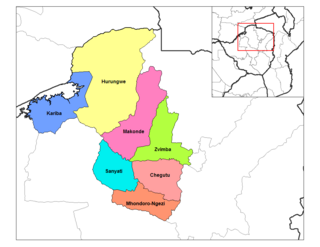
Manicaland is a province in eastern Zimbabwe. After Harare Province, it is the country's second-most populous province, with a population of 2.037 million, as of the 2022 census. Making it the third most densely populated province after Harare and Bulawayo provinces. Manicaland was one of five original provinces established in Southern Rhodesia in the early colonial period. The province endowed with country's major tourist attractions, the likes of Mutarazi Falls, Nyanga National Park and Zimbabwe's top three highest peaks. The province is divided into ten administrative subdivisions of seven rural districts and three towns/councils, including the provincial capital, Mutare. The name Manicaland is derived from one of the province's largest ethnic groups, the Manyika, who originate from the area north of the Manicaland province and as well as western Mozambique, who speak a distinct language called ChiManyika in Shona.

The Chinhoyi Caves are a group of limestone and dolomite caves in north central Zimbabwe. Designated a National Park in 1955, and managed by the Zimbabwe Parks & Wildlife Management Authority.
Alaska is a small town in central northern Zimbabwe in Makonde District, Mashonaland West Province.
Banket is a town in the province of Mashonaland West, Zimbabwe. It is located about 95 km north-west of Harare on the main Harare-Chinhoyi road. According to the 1982 Population Census, the town had a population of 5,698. The name of the town is derived from banket rock formation: early settlers saw a conglomerate, which they hoped would bear gold, like the banket of the Witwatersrand gold fields. The conglomerate was not gold-bearing, although gold was late discovered and, along with chromite, is still mined in the area. Cattle, maize, cotton and tobacco are commercially farmed in the area.
Sanyati is a town in Zimbabwe.
Lion's Den is a small town in Zimbabwe.
Karoi is a town in Zimbabwe.

Mwami is a settlement in the province of Mashonaland West, Zimbabwe.

Lomagundi College is an independent, co-educational, boarding and day, senior school in Zimbabwe which is situated about 130 km northwest of the capital Harare along the Harare-Chirundu highway on the outskirts of Chinhoyi the provincial capital of Mashonaland West.
Murombedzi is a town in Zimbabwe.

Karoi District is a district of Mashonaland West Province, Zimbabwe. The district is also known as Hurungwe District which extends to Zambian border. The Hurungwe district office are found in Karoi town.

Zvimba District is a district of Mashonaland West Province, Zimbabwe.

Makonde District is a district in Zimbabwe.
The Battle of Sinoia, also known as the Battle of Chinhoyi was a small military engagement fought near Sinoia between a small unit of Zimbabwe African National Liberation Army (ZANLA) guerrillas and the Rhodesian police force on 28 April 1966. The skirmish is generally considered the opening engagement of the Rhodesian Bush War A team of seven ZANLA cadres engaged with British South Africa Police forces near the northern town of Sinoia. The seven guerrillas all eventually died in the battle, the police killing all seven.
The R3 highway is a primary road in Zimbabwe that runs from the capital city, Harare, to the Chirundu Border Post with Zambia. It is also known as the A1 highway. It is part of both the Beira–Lobito Highway and the Cape to Cairo Road.

Chirundu–Beitbridge Road Corridor is a Trans-African Highway Network Zimbabwean link between South Africa and Zambia. It is part of the North–South Corridor Project and forms the entire Zimbabwean section of the Cape to Cairo Road.
The P12 Makuti-Kariba Highway is a 2-way asphalt surface international highway from the A1 Highway at Makuti to Zambia via the Kariba Dam Wall. The maximum speed on this road is 120 kilometres (75 mi) per hour. It is part of Zimbabwean trunk road system.

The A12 is a road in Zimbabwe running from the A11 just past Mazowe, just over 30 km from Harare, to Centenary about 145 km from Harare.
Italian Zimbabweans are citizens or residents of Zimbabwe of Italian heritage. The phrase may refer to someone born in the Zimbabwe of Italian descent, someone who has emigrated from Italy to Zimbabwe, a person with Italo-Zimbabwean heritage or someone born elsewhere, who is of Italian descent and has migrated to Zimbabwe. Italian Zimbabweans form one of the younger communities of the Italian diaspora, largely a product of wartime and post-war immigration.









